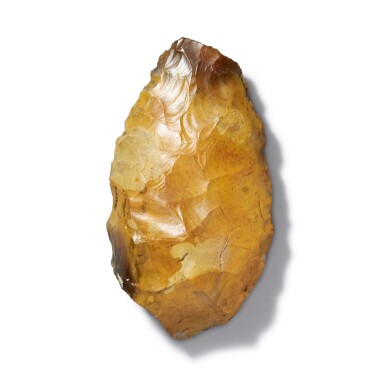
Paleolithic (Acheulean) Handaxe
Lower Paleolithic (approx. 700,000-300,000 years ago), Longueil-Sainte-Marie, Oise, France
No reserve
Auction Closed
July 17, 03:28 PM GMT
Estimate
3,000 - 5,000 USD
Lot Details
Description
Paleolithic (Acheulean) Handaxe
Produced by Homo heidelbergensis
Lower Paleolithic (approx. 700,000-300,000 years ago)
Longueil-Sainte-Marie, Oise, France
6⅛ x 3⅜ x 1½ inches (15.5 x 8.5 x 3.9 cm).
A large and extremely well preserved orange flint handaxe (biface) knapped on both sides, showing collection marks of the original field collector, Jean-Claude Debenne.
Field collected by Jean-Claude Debenne (1936-2020), Oise, France.
Included with French and European Union export licenses.
THE ORIGINS OF HUMAN TECHNOLOGY
Homo heidelbergensis is an extinct species of archaic human that lived in Europe, Africa, and possibly Asia from approximately 700,000 to 300,000 years ago. The species is named after the town of Heidelberg, Germany, where the first specimen was discovered in 1907, and named shortly thereafter by anthropologist Otto Schoetensack. Homo heidelbergensis is considered to be the most recent common ancestor between modern humans and Neanderthals.
Although stone toolmaking has been attributed to both Homo habilis and various australopithecines between 2.5 and 1.5 million years ago, the Acheulean stone tool industry of Homo erectus and Homo heidelbergensis constituted a technological revolution, best characterized by the handaxe as offered here (see also Lots 46 and 47). Acheulean handaxes were the first stone tools to be worked symmetrically on both sides, and would have been used for cutting, hunting, butchering, and digging in soil. The shaping of two-sided handaxes – also known as bifaces – through the process of knapping (removing flakes around the core of a stone) is a complex skill that archaeologists have attributed to an increase in prefrontal brain activity and a high degree of working memory, both vital to the development of modern human cognition.
This handaxe was field collected by Jean-Claude Debenne (1936-2020) in Oise, France, and his original collection marks can be seen on the specimen. Debenne was a former member of the French Prehistoric Society and the Southwest [France] Prehistoric Association, as well as an honorary member of the Île-de-France Geological Club.
Included with this handaxe are export licenses from both the French government and the European Union.
REFERENCES:
De la Torre, Ignacio. “The Origins of the Acheulean: Past and Present Perspectives on a Major Transition in Human Evolution.” Phil. Trans. R. Soc. B 371, no. 1698 (2016): 1–13.
